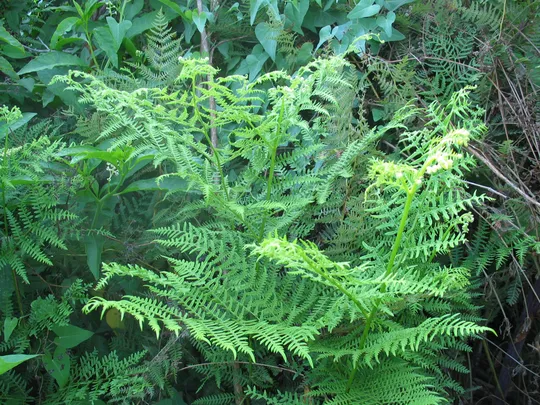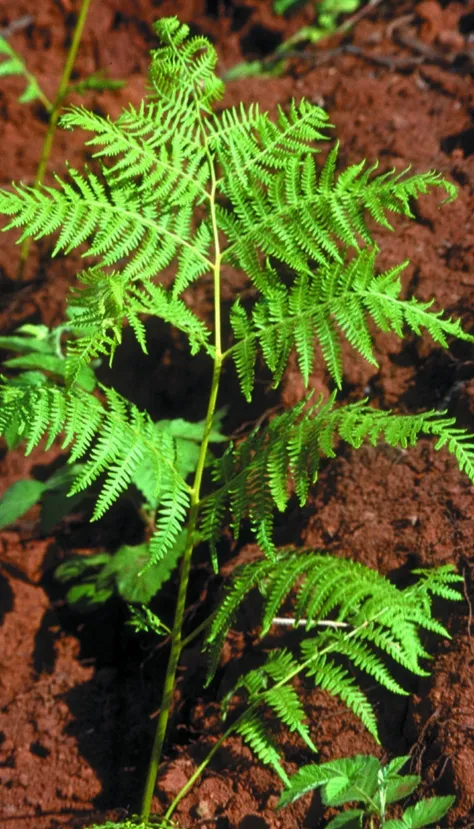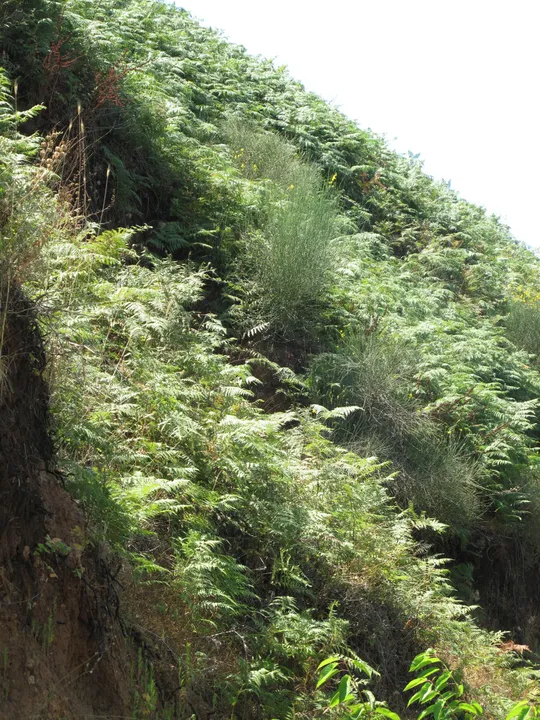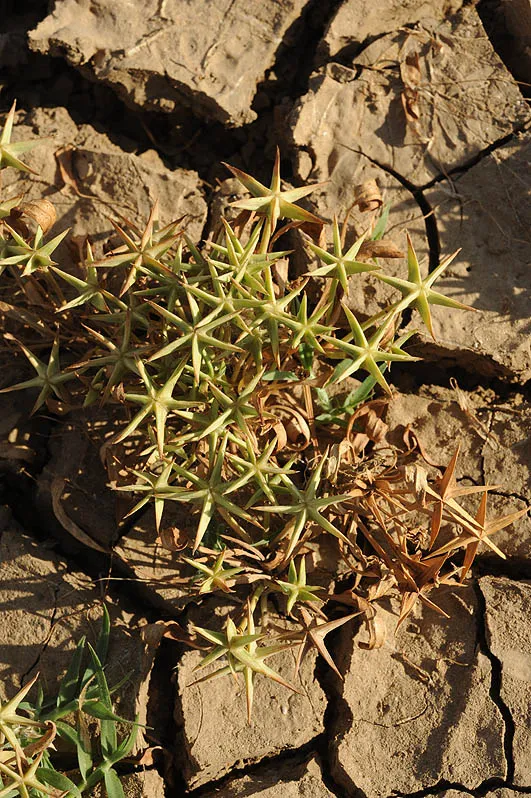Common Bracken Fern, Common Brake
Pteridium aquilinum



Pteridium aquilinum is an erect perennial fern up to a few
dozen centimeters tall. Its thickened rhizome spreads and branches below
ground. The frond blade is triangular and 3-pinnate. Nectaries at the base
of the fronds attract ants. The leaves are toxic to
livestock and to neighboring plants (allelopathic). The spores are arranged
in strips along the leaflet margins. The plant propagates vegetatively by its
branching rhizome; in many countries, it is considered a
pesticide-resistant noxious weed. It apparently tends to atrophy in shady
conditions (Ati Yaffe, personal communication).
The thickened rhizomes contain starch and are consumed in various parts of the world, although they have been found to contain carcinogenic compounds. The rhizome was also once used in tanneries and in the soap industry. Paper was prepared from the leaves and leaf extracts were used for preparing dyes. In Turkey it is used as padding for carts that transport agricultural products.
Grows currently and grew in the past in the Hula Valley. It was collected in the Hula during the 1930s and ‘40s, and was identified again in 1967. A single population survived in the area of the drained Hula Lake at the original site where the Enan Stream flowed into the Hula Lake. Since 1998, the species has been recorded in the Hula Reserve (Talia Oron and Didi Kaplan) and it has re-established itself after a 30-year extinction period (1967-1998). These are possibly European plants or a feral population. After 1967 a population of hundreds of plants was discovered in the northern Golan, growing at the edge of a spring on the southern shore of the Ram Lake. This population grows in direct sunlight on a slope of basaltic soil and a scoria substrate from which water flows. An apparently new population is growing at Kibbutz Dafna fish ponds, possibly from a cultured source; evidently growing numbers of fern species "escape" into open spaces.
In Israel: at the edge of marshes, springs and streams in cool climates in the north. In countries north of Israel (with year-rounnd precipitation) it grows in disturbed places, in deforested areas or in places where earthworks and road building took place, occasionally in moist depressions. It is a noxious weed in cultivated fields.
A single species in the Hypolepidaceae family. The genus has only one species with two subspecies: the aquilinum subspecies that grows in the Northern Hemisphere and Africa, and the caudatum subspecies that grows in the Southern Hemisphere.
• Water bodies drying up can lead to the extinction of the Ram Lake population.
• The plant has only one surviving population and it is cut off from the populations in countries to the north.
• The Lake Ram population includes hundreds of individuals.
• It is a very rare, severely threatened plant in Israel, but not endangered globally.
• It is not a protected plant in a nature reserve, but being a fern it is designated a protected plant.
The Ram Lake population should be protected; it is peripheral, natural and fragmented. It should be naturalized only in the Hula Lake. Naturalized populations should be strictly monitored due to the species’ potential for aggressive expansion.
Cosmopolitan. This is the most common fern in temperate regions. The Hula population is the southernmost in the Middle East.
An extremely common fern known as an aggressive noxious weed and a species typical of disturbed habitats. In Israel, however it is a peripheral plant limited to moist habitats. Currently only one permanent population is known, at the Ram Lake (the population at the Dafna fish ponds is new). It was formerly found at the Hula Lake but it became extinct following the drainage, but since 1998there is evidence of its re-appearance. Naturalization should be conducted only in the Hula Lake area (Agamon), where it should be carefully monitored. The Ram Lake population, which is natural and peripheral, should be protected.
נמליך, ח. ואלטיזר, י. 1985. השרכניים בשראל. הוצאת דביר, ירושלים-תל אביב.
Current Occupancy Map
| 1000 squre meter pixel | 5000 squre meter pixel | 10000 squre meter pixel | |
|---|---|---|---|
| number of observations | 0 | 0 | 0 |
| in total pixels | 0 | 0 | 0 |
| Family | Hypolepidaceae |
| Classification | On the endangered species list |
| Ecosystem | Mediterranean humid |
| Chorotype | Multi-regional, Cosmopolitan, Central Euro-Siberian |
| Conservation Site | Hula Lake |
| Rarity |
1
5
6
|
|---|---|
| Vulnerability |
0
3
4
|
| Attractiveness |
0
1
4
|
| Endemism |
0
0
4
|
| Red number |
1
5.3
10
|
| Peripherality | N |
| IUCN category | DD EW EX LC CR EN VU NT |
| Threat Definition according to the red book | Critically endangered |
 Based on:
Based on:






